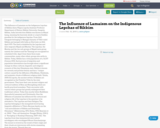
The Influence of Lamaism on the Indigenous Lepchas of Sikkim
Anira Phipon Lepcha
Assistant Professor
Department of History
Sikkim University, Gangtok, Sikkim, India
Introduction
Sikkim was known as Mayal lyang, meaning the heavenly abode or a land of hidden paradise for the indigenous lepchas. From 1642, Chogyals belonging to Namgyal dynasty of Tibet ruled Sikkim and merged with India as 22nd state on 26th April 1975. The land is inhabited by the Lepchas and later migrants Nepali and Bhutias. The Lepchas, the Bhutias and the two sub-groups of Nepali meta group namely the Limboos and the Tamangs are recognized as scheduled tribe. Apart from these three main communities, many other ethnic groups also settle in Sikkim. Today, Sikkim has a total population of 6, 10,577 (Census 2011). Such process of migration and population intermixture has brought about a significant change in ethno-cultural, linguistic and religious scenario of this tiny Himalayan state.
Sikkim is known for serenity and pristine beauty and has a “unique culture caused by the diffusion of Buddhism, Hinduism, and animistic rituals of different religious faith.”(Gulia, 2005:13) Lepcha, the ancient settlers of Sikkim are recognized as the Primitive Tribe by the state government. They have their own ancient religion and cultural tradition of Mun and Boongthing which are hardly practiced nowadays. Their encounter with various ethnic groups has greatly endangered their traditional culture. Today they mostly follow Buddhism (henceforth Lamaism) and Christianity. How the diffusion of Lamaism has influenced the cultural and religious life of the Lepchas is the question to be attended to.
The Lepchas and their Religion
The Lepchas belonging to the mongoloid stock having linguistic affiliation to Tibeto-Burman family are the “real autochthones of Sikkim and Darjeeling Himalayas” (Mainwaring, 1876; Risley, 1928; Banerjee et al, 1980).” They call themselves ‘Rongpa’(Risley, 1928:1) or ‘Raongkup or Rumkup’(Tamsang, 2009: 652) . The Lepchas from time immemorial were nature worshippers who worshipped Mount Kanchanjunga. The mount is revered as the womb of their origin and their rituals are interwoven with stories emanating from the mount. Though they are
- Subject:
- Arts and Humanities
- Material Type:
- Case Study
- Date Added:
- 02/14/2019